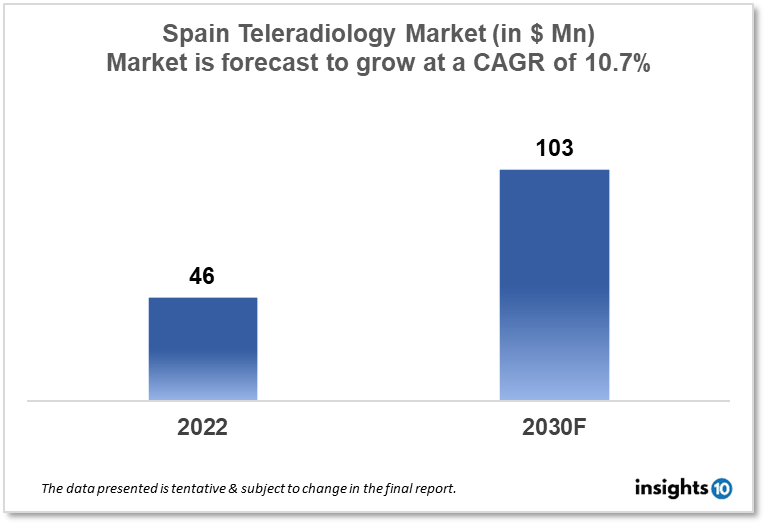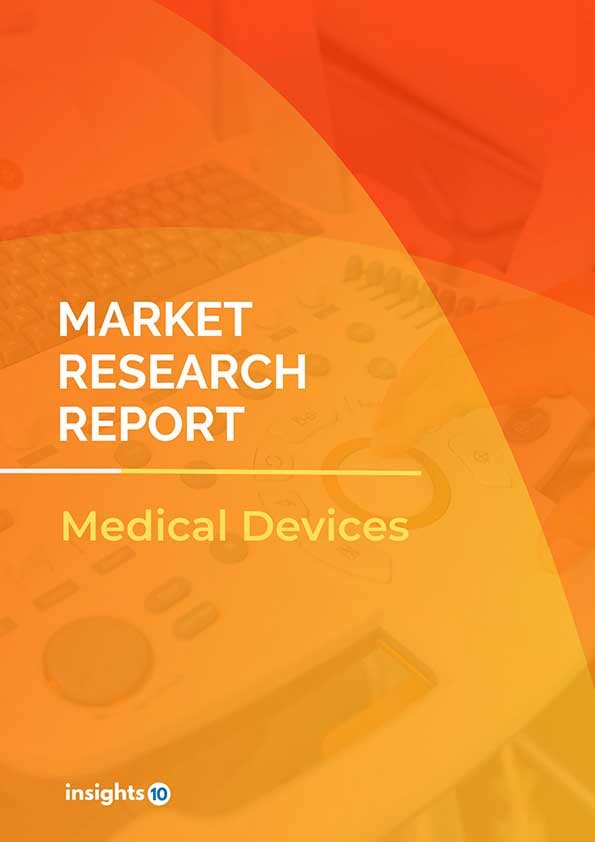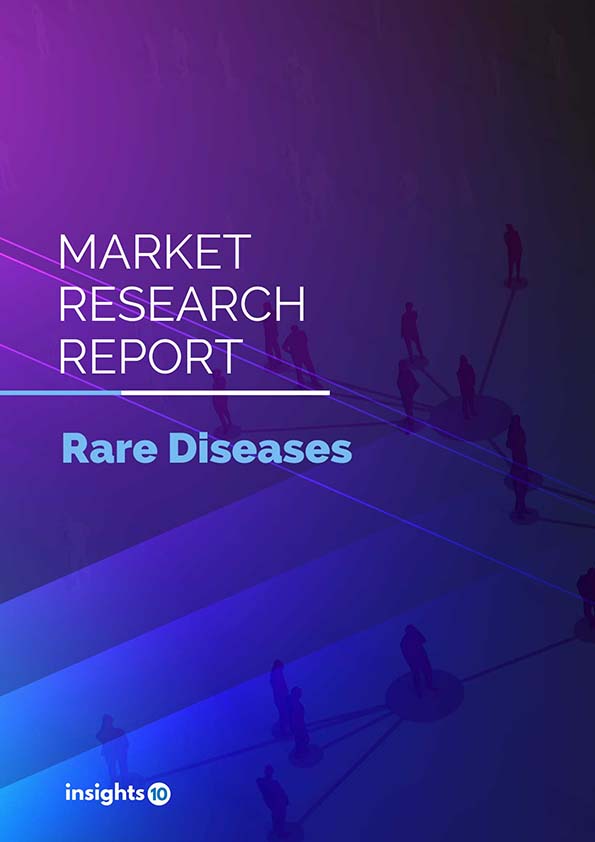Spain Teleradiology Market Analysis
Spain's Teleradiology market size was valued at $46 Mn in 2022 and is estimated to expand at a compound annual growth rate (CAGR) of 10.7% from 2022 to 2030 and will reach $ 103 Mn in 2030. The market is segmented by application, modality, technology solutions, and end user. Teleradiology is becoming increasingly popular in Spain due to the growing demand for remote healthcare services, particularly in rural or underserved areas. The key market players are Radiber, Teleradiología de España, Medicasur, Hospital Clínic de Barcelona, and Telerradand others.
Buy Now

Spain Teleradiology Market Executive Summary
Spain's Teleradiology market size was valued at $46 Mn in 2022 and is estimated to expand at a compound annual growth rate (CAGR) of 10.7% from 2022 to 2030 and will reach $ 103 Mn in 2030. According to data from the World Bank, Spain's healthcare expenditure as a percentage of GDP was 9.3% in 2019. This represents a total healthcare expenditure of approximately $177 Bn in 2019.
The use of teleradiology can help to reduce healthcare costs by providing more efficient and cost-effective access to medical imaging services. Additionally, teleradiology can help to reduce the need for expensive and time-consuming transfers of patients between hospitals for diagnostic purposes.
The adoption of teleradiology in Spain is increasing due to the benefits it provides, such as increased access to radiology services, improved patient outcomes, and reduced costs. This trend is likely to continue in the future, as more hospitals and clinics adopt teleradiology services as part of their overall healthcare strategy.
Teleradiology is a rapidly growing field in Spain, and has become an increasingly important part of the country's healthcare system in recent years. Teleradiology services in Spain are primarily provided by private companies, although some public hospitals and healthcare centers also offer teleradiology services. Teleradiology services are increasingly being used to provide round-the-clock coverage to hospitals and clinics, particularly in rural and remote areas that have limited access to radiologists. AI is being used in teleradiology to help radiologists analyze medical images more efficiently and accurately. For example, AI algorithms can be used to help detect abnormalities in medical images, reducing the time and effort required for radiologists to analyze the images. The use of teleradiology has raised concerns about the quality and accuracy of diagnostic results. To address this, teleradiology companies in Spain are implementing rigorous quality control measures to ensure the highest standards of patient care. Overall, the teleradiology market in Spain is evolving rapidly, and these emerging trends are likely to shape the future of teleradiology in the country.

Market Dynamics
Market Growth Drivers
- Improved patient outcomes: Teleradiology can lead to faster turnaround times for radiology reports and reduce the risk of misdiagnosis, leading to improved patient outcomes.
- Increasing demand for remote healthcare: Teleradiology is becoming increasingly popular in Spain due to the growing demand for remote healthcare services, particularly in rural or underserved areas.
- Shortage of Radiologists: Spain is facing a shortage of radiologists in many regions, which is driving the demand for teleradiology services.
- Advancements in technology: Advancements in technology, such as electronic medical records (EMRs) and picture archiving and communication systems (PACS), have made it easier to transmit and store medical images securely, increasing the adoption of teleradiology.
Market Restraints:
- Resistance to change: Traditional healthcare providers may be resistant to change and the adoption of new technology, which can slow the growth of the teleradiology market.
- Data protection: Teleradiology providers must comply with data protection regulations in Spain, including the General Data Protection Regulation (GDPR), which can increase the costs and complexity of providing teleradiology services.
- Language barriers: Spain has many regions with different languages and dialects, which can make it difficult for teleradiology providers to communicate effectively with patients and healthcare providers in some areas.
- Legal and regulatory challenges: Teleradiology services must comply with various legal and regulatory requirements, such as licensing and quality standards, which can increase the costs and complexity of providing teleradiology services.
- Lack of standardization: There is a lack of standardization in teleradiology practices, leading to variations in the quality of services provided
Competitive Landscape
Key Players
- Radiber
- Teleradiología de España
- Medicasur
- Hospital Clínic de Barcelona
- Telerrad
- Teleimagen
- Teleradiología Madrid
- Mediktor
- Medimaging Integrated Solutions
Notable Deals
2020: Radiber acquired Spanish teleradiology company Teleradiología de España
2019: Telemedicine Clinic Spain partnered with Spanish hospital group Quirónsalud in 2019 to provide teleradiology services.
Healthcare Policies and Regulatory Landscape
Teleradiology regulations in Spain are mainly governed by the Spanish Royal Decree 1131/2002 of September 6, which establishes the minimum requirements for the provision of teleradiology services. Some of the key regulations related to teleradiology in Spain are:
Licensing and accreditation: Teleradiology service providers must be licensed and accredited by the competent authorities in Spain, and comply with the relevant quality standards and guidelines.
Data protection and patient confidentiality: Teleradiology service providers must comply with the Spanish Data Protection Act and ensure the confidentiality and security of patient data.
Technical requirements: Teleradiology service providers must ensure that the technical infrastructure used for teleradiology services is reliable, secure and complies with the relevant technical standards.
Reporting and record-keeping: Teleradiology service providers must maintain accurate records of all teleradiology reports, and ensure that they are available to the referring physicians and other authorized healthcare professionals.
Professional liability insurance: Teleradiology service providers must have appropriate professional liability insurance to cover any potential harm or damage caused by their services.
1. Executive Summary
1.1 Digital Health Overview
1.2 Global Scenario
1.3 Country Overview
1.4 Healthcare Scenario in Country
1.5 Digital Health Policy in Country
1.6 Recent Developments in the Country
2. Market Size and Forecasting
2.1 Market Size (With Excel and Methodology)
2.2 Market Segmentation (Check all Segments in Segmentation Section)
3. Market Dynamics
3.1 Market Drivers
3.2 Market Restraints
4. Competitive Landscape
4.1 Major Market Share
4.2 Key Company Profile (Check all Companies in the Summary Section)
4.2.1 Company
4.2.1.1 Overview
4.2.1.2 Product Applications and Services
4.2.1.3 Recent Developments
4.2.1.4 Partnerships Ecosystem
4.2.1.5 Financials (Based on Availability)
5. Reimbursement Scenario
5.1 Reimbursement Regulation
5.2 Reimbursement Process for Diagnosis
5.3 Reimbursement Process for Treatment
6. Methodology and Scope
Teleradiology Market Segmentation
By Application
- Picture Archiving and Communication System (PACS)
- Radiology Information System (RIS)
By Modality:
The market is divided into X-ray, computed tomography (CT), ultrasound, magnetic resonance imaging (MRI), nuclear imaging, fluoroscopy, and mammography segments based on Modality. The computed tomography market category held the biggest market share in 2020. Several medical specialties employ computed tomography, including cardiology, cancer, neurology, abdominal and pelvic imaging, as well as spine and musculoskeletal imaging. The teleradiology market is expanding in this sector due to factors including the rising demand for early and accurate diagnosis, technical improvements, and digitalization in this industry. Around 100 million CT scans are performed annually worldwide, according to the WHO. The demand for CT scans over other imaging modalities has increased due to the desire to avoid exploratory procedures and advancements in cancer diagnosis and therapy.
- X-Ray
- Magnetic Resonance Imaging
- Computed Tomography
- Ultrasound Systems
- Nuclear Imaging
By Technology Solutions
- Web-Based Teleradiology Solutions
- Cloud-Based Teleradiology Solutions
By End User
The market is divided into four categories based on the end users: long-term care facilities, nursing homes, and assisted living facilities; hospitals and clinics; diagnostic imaging centres and laboratories; and other end users. In 2019, the hospitals and clinics segment's revenue contribution was the highest. This segment's significant market share can be ascribed to the increase in diagnostic imaging operations carried out in hospitals, the hospitals' growing propensity to automate and digitise patient data, and the growing demand to raise the standard of patient care. In addition, the COVID-19 pandemic shortage of radiologists and the growing usage of new imaging modalities to boost hospital workflow efficiency are anticipated to enhance the development of this end-user segment.
- Hospitals and Clinics
- Diagnostic Imaging Center and Laboratories
- Long-term Care Centres, Nursing Homes, Assisted Living Facilities
- Others
Methodology for Database Creation
Our database offers a comprehensive list of healthcare centers, meticulously curated to provide detailed information on a wide range of specialties and services. It includes top-tier hospitals, clinics, and diagnostic facilities across 30 countries and 24 specialties, ensuring users can find the healthcare services they need.
Additionally, we provide a comprehensive list of Key Opinion Leaders (KOLs) based on your requirements. Our curated list captures various crucial aspects of the KOLs, offering more than just general information. Whether you're looking to boost brand awareness, drive engagement, or launch a new product, our extensive list of KOLs ensures you have the right experts by your side. Covering 30 countries and 36 specialties, our database guarantees access to the best KOLs in the healthcare industry, supporting strategic decisions and enhancing your initiatives.
How Do We Get It?
Our database is created and maintained through a combination of secondary and primary research methodologies.
1. Secondary Research
With many years of experience in the healthcare field, we have our own rich proprietary data from various past projects. This historical data serves as the foundation for our database. Our continuous process of gathering data involves:
- Analyzing historical proprietary data collected from multiple projects.
- Regularly updating our existing data sets with new findings and trends.
- Ensuring data consistency and accuracy through rigorous validation processes.
With extensive experience in the field, we have developed a proprietary GenAI-based technology that is uniquely tailored to our organization. This advanced technology enables us to scan a wide array of relevant information sources across the internet. Our data-gathering process includes:
- Searching through academic conferences, published research, citations, and social media platforms
- Collecting and compiling diverse data to build a comprehensive and detailed database
- Continuously updating our database with new information to ensure its relevance and accuracy
2. Primary Research
To complement and validate our secondary data, we engage in primary research through local tie-ups and partnerships. This process involves:
- Collaborating with local healthcare providers, hospitals, and clinics to gather real-time data.
- Conducting surveys, interviews, and field studies to collect fresh data directly from the source.
- Continuously refreshing our database to ensure that the information remains current and reliable.
- Validating secondary data through cross-referencing with primary data to ensure accuracy and relevance.
Combining Secondary and Primary Research
By integrating both secondary and primary research methodologies, we ensure that our database is comprehensive, accurate, and up-to-date. The combined process involves:
- Merging historical data from secondary research with real-time data from primary research.
- Conducting thorough data validation and cleansing to remove inconsistencies and errors.
- Organizing data into a structured format that is easily accessible and usable for various applications.
- Continuously monitoring and updating the database to reflect the latest developments and trends in the healthcare field.
Through this meticulous process, we create a final database tailored to each region and domain within the healthcare industry. This approach ensures that our clients receive reliable and relevant data, empowering them to make informed decisions and drive innovation in their respective fields.
To request a free sample copy of this report, please complete the form below.
We value your inquiry and offer free customization with every report to fulfil your exact research needs.










































